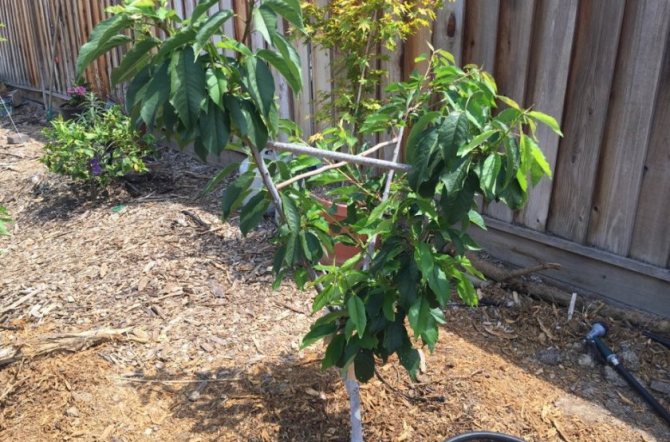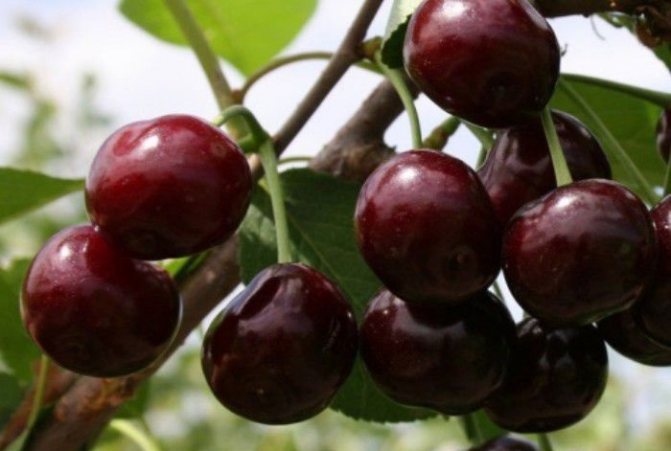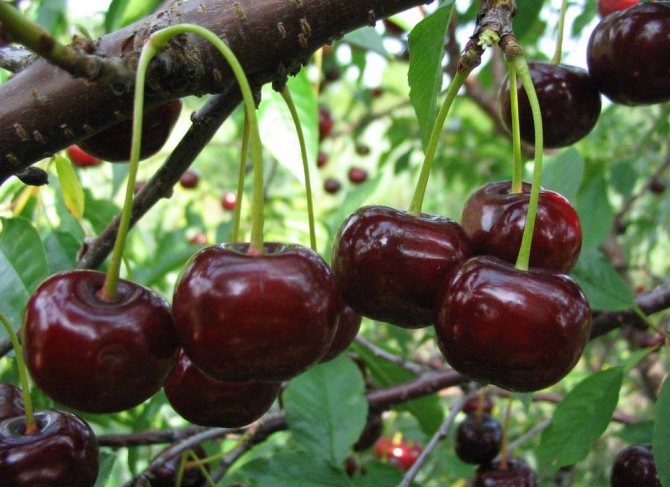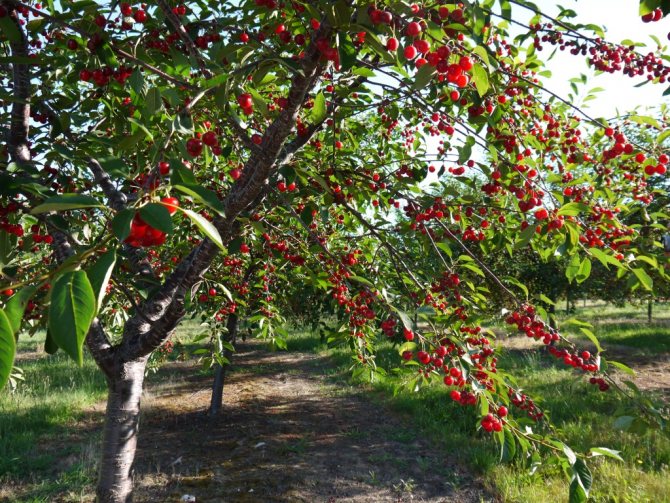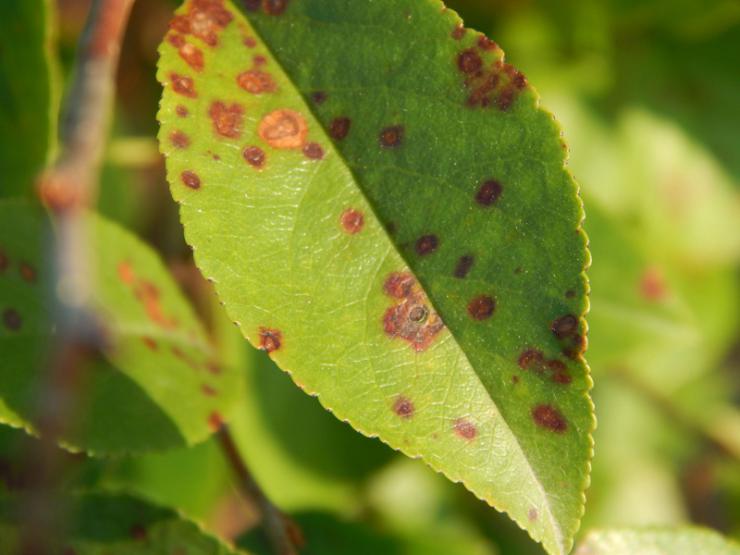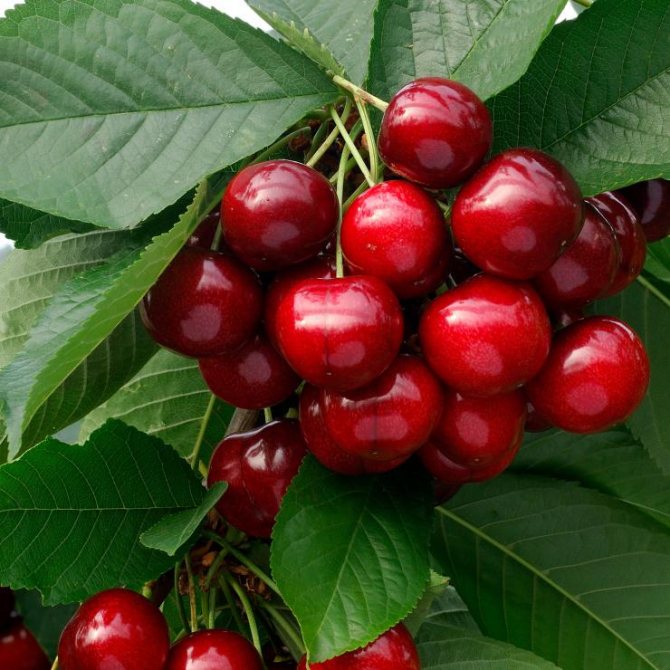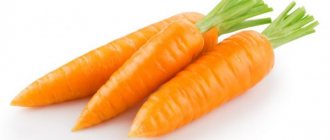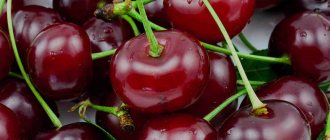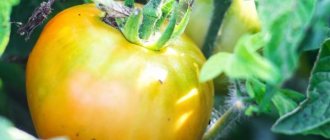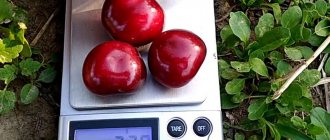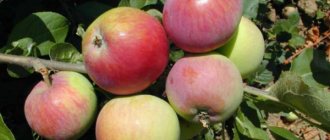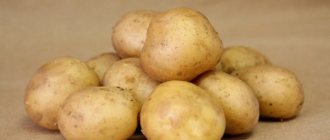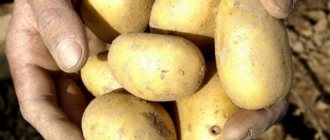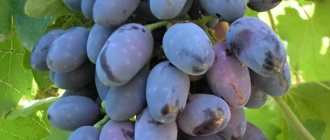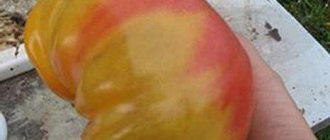Not all cherry varieties are suitable for cultivation in the northern regions of Russia. The Ural Standard variety is in demand among amateur gardeners in the region. It was bred by the breeders of the Sverdlovsk Horticultural Station of the Research Institute of Agriculture and the Central Research Institute of Agriculture in the Urals (today the All-Russian Research Institute of Genetics, Breeding of Fruit Plants named after Michurin) using seedlings of shrub and steppe cherries selected by I.V. Michurin specifically for these purposes.
The bush rarely grows more than 1.5-2 m in height. The culture is valued for its high winter hardiness, disease resistance, early maturity.
Cherry fruits are large, with a sweet-sour taste, dark red. The crop begins to ripen in August. The Ural standard is a self-fertile cherry variety, the best pollinator for it is the Ural ruby steppe culture.
What varieties are suitable
Not all cherries are suitable for the Urals, so the varieties here should be chosen carefully. This is due to the fact that this region has not very comfortable conditions for planting and growing seedlings of fruit trees. Here, as in Siberia, the climate has the following features:
- cold winters;
- short summer;
- spring and autumn frosts.
Therefore, fast-growing and frost-resistant varieties that give a high yield are suitable here. At the same time, it is desirable that the tree be resistant to disease. Breeders are constantly working to develop new varieties of trees with special characteristics. Therefore, the best cherry varieties suitable for cultivation in the Urals are often replenished with new representatives. Give such trees comprehensive care and attention and they will thank you with delicious fruits even in such harsh regions.
Growing
For normal growth, Standard Ural cherries need competent agricultural technology:
- Climatic conditions - choose the site, as for other varieties, from cold winds, warm, sunny. High humidity is harmful to shrubs - if possible, plant on hills, elevations, or simply in those places where the groundwater is quite deep (at least 2 m).
- Soil slightly acidic, fertile, nutrient-rich and neutral are suitable. The mechanical composition is either light loam, or sandy, or sandy loam. If the soil is acidic, add 5 kg of dolomite flour to the hole, you can add another bucket of sand to each hole.
- Landing is done using high-quality seedlings, since poor planting material simply will not grow. They should be bought in specialized stores or nurseries, give preference to trees with developed roots. Water the soil constantly - both in the container and in the planting hole. The seedling buds should be intact, without signs of disease or damage, and the roots should be fresh, without dry parts.
Read about cherry varieties for the Urals here.
Pre-treat the roots of the planting material with Kornevin and soak.
The procedure for planting shrubs in open ground:
- Is being done hole marking at a distance of about 2 m from each other (since the shrubs are small). Do not forget about the need to plant pollinators on the site, if they are not already there, and if there is, draw up a scheme taking into account the peculiarities of the location of different trees.
- Pit dug to a depth of 68-80cm, the width may be slightly smaller.
- Topsoil it is separated, mixed with compost, peat, manure (take strictly rotted) at choice in a ratio of 1 to 1. Remove the lower clay parts or leave to form the sides of the hole. Potassium-phosphorus fertilizers can be added to the planting hole - about 300 g.
- To the bottom of the fossa fine gravel or crushed stone is filled up - this is necessary to create high-quality drainage.
- Humus, dolomite flour, a mixture of soil and humus are thoroughly mixed, then fill the hole with the resulting mass a little more than half, a peg is installed.
- A hill is forming from the ground, the roots are gently straightened. The neck of the roots should be at the level of the soil.
- Seedling sinks into a hole and falls asleep.
That's all - it remains to tie the seedling to the peg, tamp the soil and form a hole for watering. Additionally, it is recommended to mulch the area around the trunk with sawdust or peat to retain moisture at the roots.
Climatic characteristics of the region
The climatic features of this region are quite severe. At the same time, there are certain differences between the weather conditions of Western and Eastern Siberia. The climate is different in the south and north of the Urals.
However, all parts of the region are characterized by cold winters and short summers. Frosts are often observed in spring and autumn. Therefore, when choosing cherry varieties, preference should be given to early-growing and frost-resistant varieties. Breeders are constantly developing new types of trees, which helps to grow berry crops even in such difficult conditions.
Breeding history
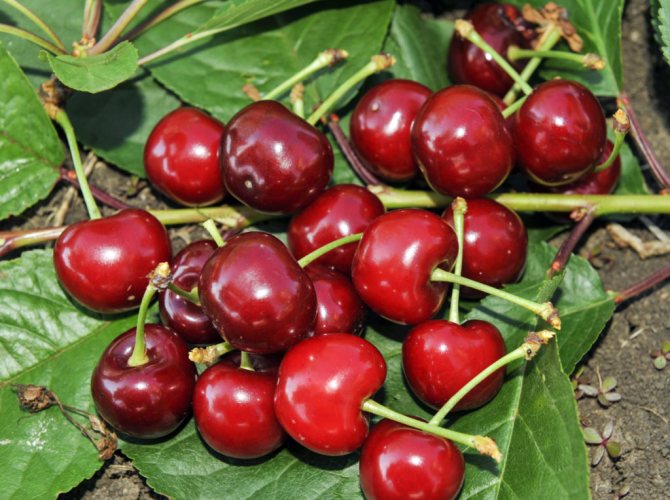
I.V. Michurin is the author of the first frost-resistant varieties of sweet cherries. Now, creating new winter-hardy forms, his Kozlovskaya, Pervenets, First Swallow are used as a source material. In Soviet times, the center of selection was the Pavlovsk experimental station VIR. There, 14 winter-hardy cherry varieties were bred for the Moscow region and the Leningrad region.
At dachas near St. Petersburg and now you can find:
- Leningrad yellow;
- Red dense;
- Dawn.
Many varieties were created by the breeders of the Bryansk Experimental Station. Their cherries Revna, Iput, Teremoshka, Kompaktnaya Venyaminova, Ovstuzhenka, Bryanochka, Rosy Sunset, Veda, Tyutchevka, Bryanskaya Rosova are popular with summer residents. The most winter-hardy varieties of Moscow selection (VSTISP) are cherries Cheremashnaya and Fatezh.
Alatyrskaya
A fairly common variety in Siberia and the Urals. Its homeland is the city of Alatyr, which gave the name to this species. The tree has the following characteristics:
- compactness. Reaches 2.5–3 m in height;
- average yield (about 5 kg);
- regular fruiting (if there was proper care in terms of frost protection);
Alatyrskaya has a late ripening period. Berries can be harvested in the second decade of August. They are almost black in color. The pulp is juicy and fleshy.
Landing features
When planting cherries in the Urals, it is necessary to follow a number of standard procedures and take into account the climatic features of the region. To avoid difficulties in growing and get a good harvest, you need to determine the appropriate timing for planting, choose a place on the site and prepare the soil.
Due to the climatic conditions in the Urals, sweet cherries are planted exclusively in spring. It is necessary to wait for the snow cover to disappear and the likelihood of return frosts disappear, and then transfer the seedling to a permanent place of growth.
The place in the garden for placing cherry seedlings must meet a number of requirements. In particular:
- solar lighting throughout the day;
- no through blowing and protection from strong wind gusts;
- low groundwater level (no higher than 2.5 m).
Cherry loves soil with a neutral acidity index, so liming should be carried out before planting. On light sandy loam soil, 300-400 g of lime are used per square, and on heavy loamy soil - 600-800 g. Organic fertilizers (wood ash, rotted manure, compost) are added to the soil mixture.
It is recommended to transfer cherry seedlings to a permanent place using standard technology. To disembark, you must:
- Dig a planting hole in a suitable area. The size of the seedling hole is about 70 x 90 cm.
- The earth is mixed with organic fertilizing and a small hill is poured into the center.
- The roots of the seedling are soaked in a growth promoter and the plant is placed in the central part of the hole.
- Sprinkle seedlings with earth, tamp the soil and water abundantly.
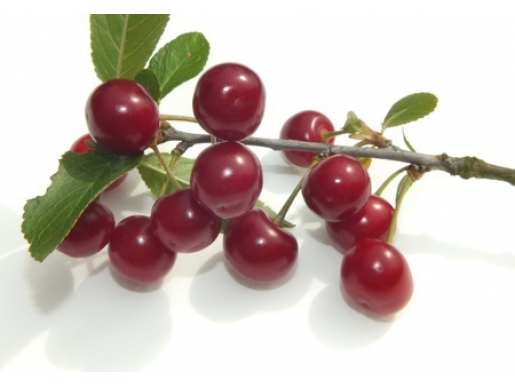

The main features of the correct planting of cherry seedlings are the observance of the intervals between neighboring plants and the preparation of the pit. All other agrotechnical measures are the same as for other fruit trees.
Seat selection
When creating plantings of dukes, cherries and cherries, it is recommended to select a site that meets the following requirements:
- Sunlight all day long. There should be no shadow, but partial shade is allowed.
- The soil must be nutritious. Wetlands are excluded.
- It is preferable to a hill, the occurrence of groundwater should not be higher than 2 m.
- Protection from drafts and winds.
- Cherry and / or cherry trees should be nearby for pollination.
- The minimum distance to neighboring crops is 5 m.
Dukes are not planted in lowlands. In winter, cold masses are concentrated here, and in summer there is too high humidity here. The best option for ducks is areas with sandy loam soils and indirect, diffused light.
Acidic soils are neutralized with chalk - 1.5 kg are added per 1 sq. m. Heavy clay soils are replaced during planting with fertile soil and sand mixed in equal parts.
Cherry seedlings are prepared for planting just like any other planting material for fruit trees. The seedlings are soaked in water a day before planting, and then all damaged roots are cut with a secateurs.
When buying dyuk seedlings, they pay attention to:
- age and time of boarding;
- grade;
- pollinators.
Saplings 2-3 years old are considered the best survival rate. Other recommendations for the choice of planting material:
- the presence of a tag indicating the age of the seedling, varietal affiliation, pollinating varieties and other details of agricultural technology;
- the trunk is straight;
- the root system is developed, without signs of disease;
- shoots are evenly colored, without gum and damage;
- the height of the main trunk is about 60 cm, the branches are shortened by a third - such signs indicate a properly prepared planting material;
- the variety should be regionalized in the region and suitable for specific climatic conditions.
You should buy saplings of dukes in nurseries or specialized farms that professionally breed fruit trees.
Landing in the ground
Dukes are best planted in early spring, when the soil warms up to the desired temperature. If you plant seedlings in the fall, they may die without taking root. Autumn planting is only suitable for regions with a warm climate.
Features of planting Duke seedlings:
- The pit is prepared a month before planting.
- The distance between adjacent pits - if 2 or more cherry seedlings are planted, 4-5 m. This is enough so that the trees, becoming adults, do not interfere with each other.
- The size of the pit should be such that the root system fits freely in it.
- Drainage must be laid at the bottom of the pit - to prevent stagnation of water near the root system. A drainage layer is made of stones or broken bricks.
- A manure-soil mixture is poured onto the drainage. The mixture includes a fertile layer.
- The soil obtained by digging a hole is mixed with superphosphate (300-400 g), potassium sulfate (250-300 g) and ash (2-3 glasses).
- If planting is carried out in infertile, depleted soil, compost or humus is introduced into the pit - one bucket.
- The seedling is placed in a pit, its roots are straightened. Sprinkle with soil so that the root collar and the surface of the earth are at the same level. Do not deepen the seedling unnecessarily - rot may develop, which will lead to the death of the young tree.
- When the seedling is planted, water is poured under the root - 2 buckets.
Gridnevskaya
It was brought from the Samara region. The description of the variety contains the following characteristics:
- excellent productivity;
- good resistance to low temperatures;
- self-infertility. Therefore, pollinators should be planted next to the seedlings;
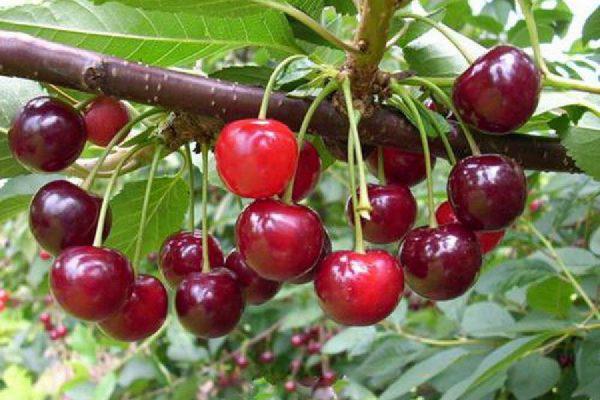

The tree forms a wide, densely leafy crown of a large size. In this connection, the variety gives a good harvest only with regular pruning. The harvest ripens in the second half of August. The fruits are dark red. The pulp is very juicy and tasty.
Preparing cherries for winter


It is necessary to prepare a fruit tree for a cold snap at the end of summer. Winter maintenance is an important stage of care, which boils down to the following aspects:
- Removing light and delicate shoot tips using the pinching method. The procedure is necessary to increase the frost resistance of plantations, rapid maturation of wood.
- If the leaf fall is delayed, the plantings are sprayed with a solution of ferrous sulfate or urea. Early leaf fall improves the formation of buds and ovaries.
- The lower branches are bent to the ground. Such branches are covered with snow and tolerate low temperatures well.
- Young plantings must be covered with a dense cloth or polyethylene. The covering material is fixed.
The last watering is carried out at the end of September. At least 30 liters of water are poured under the planting. In adult trees, the trunks and bases of skeletal branches must be whitened. This will help protect the bark from infestation.
The best varieties for the Urals and Siberia
Due to the instability of the climate in all regions of the Urals, gardeners prefer early-ripening cherries, counting on the fact that such varieties have time to ripen even in the most unfavorable, rainy and cold summers. However, in regions with more stable weather, it is possible to grow typical mid-season summer varieties, and even late ones (Dream and Ryabinovaya).
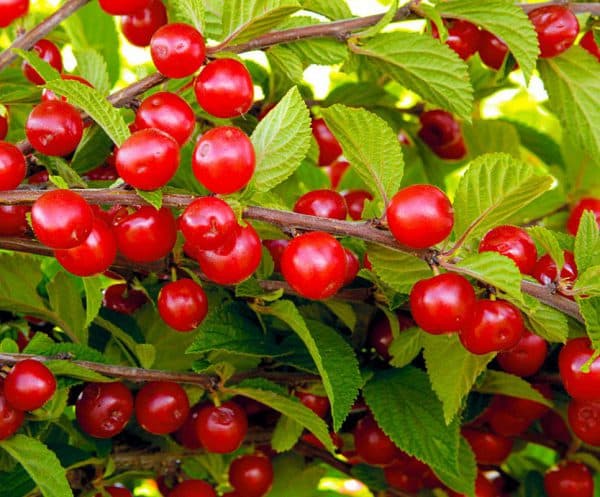

The most popular are those that combine resistance to changeable weather and high yields.
Bessey
Besseya is one of the best cherry varieties. As a matter of fact, this is not a tree, but a fruit shrub, reaching a height of no more than 1 m. The crown is spreading, but the secondary shoots already grow almost vertical, so that in general it turns out to be an extremely compact tree.
Bessei's characteristics consist of some exclamation marks:
- the culture is extremely viable: cherry perfectly tolerates both Siberian frosts and drought. Moreover, weather conditions do not affect the ripening of the crop;
- Besseya begins to bear fruit at 1 year of life. Already at 4 years of age, the harvest reaches its maximum and does not decrease;
- cherry blossoms profusely, literally strewn with flowers in spring, and in summer the branches are almost invisible behind the mass of fruits. At the same time, the berries hold well and do not crumble even under a strong wind;
- cherry large, purple-black, spherical. Taste - tart-sweet, ideal both for fresh consumption and for preservation. The skin is dense, so cherries are easy to transport, and when preserved, they also retain their shape;
- besides, the tree is very decorative. The combination of narrow, silvery-green leaves with white flowers and almost black berries looks beautiful, and in the fall the foliage acquires a bright coral-red color.
The only drawback of cherries can be considered only self-fertility. In order for Besseya to produce a crop, it is necessary to plant pollinating plants in the garden - plum-cherry hybrids, for example.
Felt cherries are a special variety that belongs to the so-called micro cherries. According to its characteristics, it is closer to peaches and apricots than to classic cherries. For its unusually sweet, almost sour taste, the berry is also called children's. The flesh of the fruit is very tender, although there are varieties with dense flesh for processing.
- Felt cherry reaches a height of 2.5 m, grows as a bush, mainly in width. It got its name for the characteristic, felt-like down on leaves, young twigs and even fruits. The tree perfectly tolerates frosts down to -25– -30. C, tolerates drought and, in general, is extremely unpretentious. The only thing he doesn't like is the winter-spring thaws, which can damage the thin twigs and bark of the cherry. Therefore, at the beginning of winter, they try to throw snow on the plants and cover them with a layer of sawdust.
- The tree begins to bloom in mid-May with pink delicate flowers. After 10-15 days, the flowers turn completely white and then crumble. The berries appear very quickly and ripen in 2 weeks. Cherries give a stable constant yield - from 5 to 10 kg per bush.
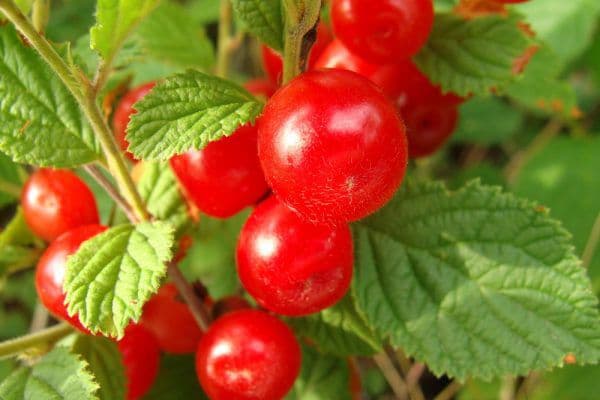

For cultivation in the Urals, varieties are chosen that are early ripening, resistant to wind and temperature extremes.
There are many varieties that can be grown in the Urals and Siberia. They differ in ripening period and other characteristics.
Early ripe
Early maturing varieties are great for these regions. The cultivation of such crops allows you to harvest before the frost begins.
Jealous
A late-ripening self-fertile variety that forms fast-growing trees of medium height.
Fruits of impressive size (up to 7.7 g) have a wide-rounded shape and dark cherry, almost black, color. The dense pulp is distinguished by an excellently sweet taste and juiciness.
Cherry Revna perfectly tolerates frost and is not afraid of fungal diseases. The best pollinators are Ovstuzhevka, Raditsa, Iput, Compact.
Poetry
High-yielding mid-ripening sweet cherry, forming low self-fruitless trees with a raised pyramidal crown.
Amber-scarlet berries of dessert use and medium size (up to 5.6 g) have an excellent taste of sweet, dense pulp with refreshing sour notes.
The variety has sufficient winter hardiness, which is quite suitable for the mild climate of southern Russia. The immunity to fungal diseases is quite high.
Ariadne
An early maturing variety with high and stable yield. Vigorous trees form impressive (up to 5.4 g) and very tasty fruits. Dark pomegranate berries are distinguished by an excellently sweet taste of dense and juicy pulp. Cherry Ariadne practically has no flaws, since it is not only tasty and fruitful, but also frost-hardy and does not get sick at all.
Oryol pink
A mid-season and high-yielding variety that forms medium-sized and frost-resistant trees. Small (up to 4.0 g) yellow fruits with a scarlet blush have a sweet, slightly sour, dessert taste of juicy, medium-dense pulp. Sweet cherry is characterized by good early maturity (fruiting - in the third year) and is relatively resistant to fungal diseases, but self-fertile.
Rechitsa
Self-fertile, medium-ripening sweet cherry with good yield. Rapidly growing trees of medium height with a spreading crown are distinguished by excellent frost resistance and high immunity to fungal diseases. Large (up to 5.8 g) fruits of almost black color have a remarkably sweet taste of juicy pulp. The best pollinators are Ovstuzhenka, Odrinka, Iput.
The Scientific and Production Association "Sady Rossii" has been introducing the latest achievements in the selection of vegetable, fruit, berry and ornamental crops into the wide practice of amateur gardening for 30 years.
In the work of the association, the most modern technologies are used, a unique laboratory for microclonal reproduction of plants has been created.The main tasks of NPO Sady Rossii is to provide gardeners with high-quality planting material for popular varieties of various garden plants and novelties of world selection.
Delivery of planting material (seeds, onions, seedlings) is carried out by Russian post. We are waiting for you for shopping: NGO "Gardens of Russia"
Hello everyone! Cherry varieties for the Urals are described with a photo in our material. Sweet cherry is a thermophilic plant, therefore it is less winter-hardy than other fruit trees. In the first half of winter, young, unripe shoots die even from slight frosts.
But, thanks to breeding work, winter-hardy high-quality varieties of sweet cherries were obtained, suitable for cultivation in the Urals, they grow and bear fruit excellently.
However, it is still a very picky tree, especially in conditions that do not meet the requirements of its growth. Remember, sweet cherry is a self-fertile culture, therefore, for pollination, it is necessary to have 2-3 varieties of sweet cherry for the Urals on the site.
The best winter-hardy cherry varieties for the Urals
Odrinka
Self-fertile sweet cherry of medium late ripening period forms low trees with a pyramidal crown, which practically do not get sick, have high winter hardiness and are not afraid of sunburn. Very large (up to 8 g) and sweet fruits of dark raspberry color with firm and juicy pulp have a universal field of application. The most suitable varieties for pollination are Rechitsa, Revna, Ovstuzhenka.
Bryanochka
Self-infertile late variety, characterized by high winter hardiness and productivity. On medium-sized trees, very elegant and impressive (up to 7.1 g) fruits of a dark beet shade ripen.
Their delicious pulp is juicy and high in sugar. Sweet cherry has a high immunity to coccomycosis and good immunity to other fungal diseases.
The pollinating varieties are Veda, Iput and Tyutchevka.
Ovstuzhenka
Medium-sized tree - up to 4 m. The crown is in the form of a ball, raised, dense. The fruits are round, with a pointed tip. The average berry weight is 5 g. The skin is thin, dense, maroon color. The pulp is juicy, sweet.
The bone is well separated. Winter hardiness of the sweet cherry variety for the Urals is good. Resistance to coccomycosis and moniliosis is high, to clasterosporiosis - medium. It starts bearing fruit for 4-5 years.
The best pollinators are Iput, Revna, Tyutchevka, Raditsa.
Iput
The height of an adult tree is up to 3.5 meters. The crown is broad-pyramidal, densely leafy. It blooms in May, ripens at the end of June. Begins to bear fruit at four to five years of age. The color of the fruit ranges from red to almost black, depending on the degree of ripeness. Average weight - 6 g.
The pulp is very juicy, medium-dense, scarlet, excellent sweet taste. Good winter hardiness, high resistance to fungal infections. Productivity - up to 50 kg per tree, depending on conditions and agricultural technology. It is a self-sterile variety.
The Bryansk varieties Revna, Bryanskaya rozovaya, Tyutchevka are well suited for pollination.
Cheremashnaya
The height of the trees reaches 5 meters. The berries are yellow, medium-sized and oval in shape. In sultry heat, the fruits can be with a pink barrel.
Winter hardiness and resistance to fungal infections are high. The cherry variety for the Urals is pollinators - Ipun, Tyutchevka, etc. Fruiting begins in the fifth year of ripening.
The weight of one berry reaches 4.5 grams, and up to 27 kg of fruits can be harvested from one tree.
Tyutchevka
A late-ripening highly productive variety, partially capable of self-pollination. Medium-sized trees and flower buds have good winter hardiness.
Dark pomegranate fruits of an impressive size (up to 7.4 g) have an excellent taste of dense, sweet and juicy pulp. They are well stored and transported.
Sweet cherry is practically not affected by moniliosis and is rarely susceptible to other fungal diseases.
Self-fertile high-yielding variety of medium early fruiting.Small trees with a compact, spherical crown form elegant berries of a small size (up to 4.6 g), amber in color with a scarlet blush. The sweet and sour pulp has a pleasant, dense structure. Cherry is resistant to the most dangerous fungal diseases and tolerates frost well. The varieties Chermashnaya and Iput are suitable for pollination.
Veda
Late ripening cold-resistant table variety. Medium-sized trees are distinguished by high productivity, forming large (up to 7.0 g), juicy and very tasty dark cherry berries. Cherry Veda has an increased immunity to coccomycosis and other fungal infections, and is not capable of self-pollination. The best cherry varieties for the Urals are partners - Tyutchevka, Revna, Bryanochka, Iput.
Gronkovaya
Self-fertile early ripe variety, recommended for cultivation in the central regions. Tall, very productive trees are resistant to winter frosts and pathogenic fungi. In the fourth year of vegetation, they bear fruit for the first time, forming dark-scarlet berries of average weight (up to 4.5 g) with an excellent taste of sweet and juicy pulp. The best pollinators are Zhurba, Krasavitsa, Narodnaya.
Large-fruited
A time-tested variety of early fruiting, not capable of self-pollination.
Rapidly developing trees of medium height with a compact crown perfectly tolerate winter cold and summer drought, are not afraid of fungal diseases, and are especially resistant to moniliosis.
Zagrebinskaya
The Zagrebinskaya cherry has good data for growing in the Urals and Siberia. The tree of this variety has a spreading and sparse crown. Shoots can grow up to two meters in height. A special characteristic of the variety is its late flowering.
Therefore, the berries can be harvested from mid-August. The yield per tree is 6 kg. The fruits have a pleasant sweet and sour taste and very juicy pulp. This is a self-fertile plant that needs pollinating neighbors. Alatyrskaya will be an excellent pollinator for Zagrebinskaya.
Dignity


Despite the good winter hardiness of the variety, young cherries need winter shelter in cold regions. The low height of the bush allows you to do this without any problems.
Among the positive qualities, gardeners distinguish:
- frost resistance;
- undemanding care;
- good yield indicator;
- resistance to fungal diseases;
- small dimensions;
- early fruiting. The first harvest can be tried 3-4 years after planting. Cherries ripen at the end of June.
and disadvantages
According to general reviews, the variety has its disadvantages:
- the need for pollinators;
- the peculiarity of the variety is that the fruits do not differ in dessert taste, their purpose is more technical. Sour-sweet aftertaste and bright color give richness to compotes and jam.
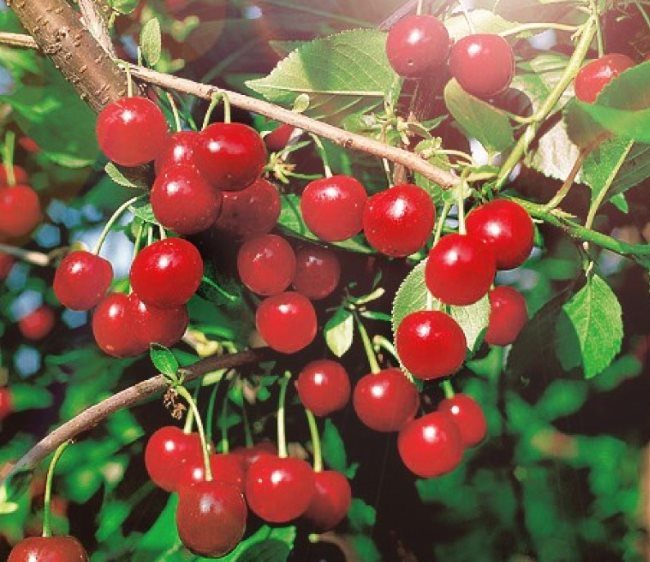

Cherry Standard of the Urals, as a rule, is grown for jam, compotes and tinctures.
Lighthouse
This is a stunted species, the crown of which is formed by spreading branches. Was bred in Yekaterinburg. If this variety is properly looked after, then up to 15 kg of berries can be removed from one plant. The fruits ripen in July. They are sweet and large. Average weight is about 6 g. The color of the peel is red. Cracking is typical. According to the characteristics of the fruit, this variety is similar to the sweet cherry.
The lighthouse has good frost resistance. However, it shows a tendency to thicken and grow. Therefore, here it is necessary to periodically remove shoots and cut off excess branches. In this case, you cannot cut off annual shoots. The lighthouse is a partially self-fertile variety. Therefore, it will produce the best yield if pollinators are planted next to it. The obvious disadvantages of the variety are poor immunity to coccomycosis.
Michurin's vole
The most favorite variety of the Ural gardeners is Michurin's Polevka. It is popular for its good cold resistance and ease of maintenance. This is an early-ripening cherry variety. Due to self-infertility, it needs a neighborhood with pollinators.Ural Standard and Generous can be used as pollinators.
Since the tree is prone to thickening, pruning will be an indispensable element of care.
Michurin's vole bears fruit in early August. Its fruits are distinguished by a bright cherry color. The taste is sweet, with an implicit sourness.
Video
Video about choosing a cherry seedling.


Cherry Standard of the Urals is distinguished by its high winter hardiness, therefore it is in demand among gardeners of the Sverdlovsk and other northern regions. The variety is obtained from shrub, steppe cherries on Sverdlovsk gardening station.
Sverdlovsk
Another popular Ural variety is Sverdlovchanka. Like Michurin's Vole, it was received from the Ideal. Trees are of a bush type and are capable of growing to a height of 2 m. Due to the density of the crown, the variety needs periodic thinning.
Cherries bear fruit in the 20th of August. With proper care, up to 10-15 kg of berries can be removed from one tree. The fruits are fleshy, covered with a dark red skin. They have a sweet taste with a slight sourness. Also, this Ural cherry is characterized by self-fertility. Here you can use Michurin's Vole and Generous as pollinators.
Cherry appearance
Outwardly, Generous does not stand out in anything: its advantages are hidden in frost resistance and endurance. An ordinary tree with a spreading crown, strewn with small, cherry-colored berries.
Wood
The trees of the variety will not be tall, so some are suitable for cultivation in the private sector and in summer cottages. The orientation of the shoots is vertical, the buds are of a characteristic sharp shape, small. The leaves are bright green, rounded, with small denticles along the contour. In one inflorescence 3-4 buds grow, petals are white, freely placed.
Cherries are small, rounded, dark wine color, weighing up to 5 grams. Ripening, they do not crack, retain their shape. The pulp is juicy, sweet, without cloying, a little sour. The bone is easily separated from the core. The tail is long, not thick. One berry contains:
- acids - about 1.5%;
- sugar - up to 7%;
- dry components - 12.2%.
In 100 grams of cherries - up to 13 milligrams of ascorbic acid, a lot (318 milligrams) of vitamin P. The fruits are resistant to shedding.
Ural standard
Cherry varieties Standard of the Urals are very popular among regional gardeners. The tree forms a wide crown at a height of 2 m. Cherry does not need to be thinned regularly, since the shoots have an average growth rate. It is considered an early variety. Fruiting falls at the end of July.
The variety is famous for its high winter hardiness and excellent productivity. From one tree, you can harvest about 13-15 kg of the crop. The fruits are large (average weight about 6.5 g). The pulp is tender, pink in color, quite juicy. The peel of the berries is scarlet. Berries do not fall off for a long time after ripening.
Care
The main measures for caring for Standard Ural cherries:
- Watering - it should not be insufficient or excessive. Moisten the soils on schedule or each time they dry out. For one irrigation, 3 buckets of water are enough; it is better to apply liquid abundantly, but rarely, than little by little, but often. Root system nutrition should be especially active during fruit setting. Before harvesting, watering is suspended - otherwise the keeping quality and transportability of the fruits will decrease. After each procedure, the soil is mulched with hay or fresh grass.
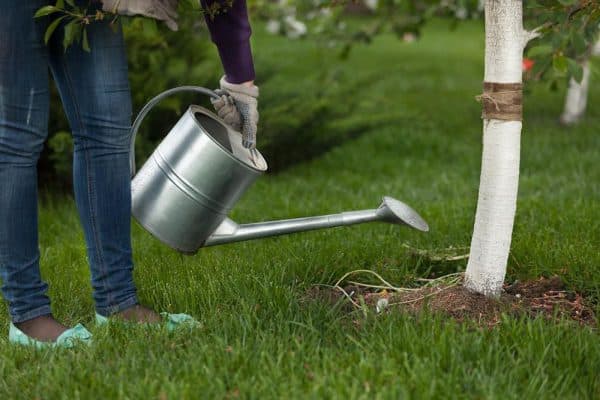

Be sure to water your cherries before frost and as soon as you harvest them.
- Fertilizers must be entered. For Standard Ural cherries, cow and bird droppings are ideal, complex mineral fertilizers can be used. It is advisable to apply fertilizing in stages - in the spring, during the period of active flowering, in the middle of summer (the period of active fruiting). Make loosening superficial - it is not recommended to be too zealous.Weeds rarely appear, but if they do, they are weeded out.
- Trimming need support for the shape of the crown, elimination of thickening, cutting of broken, young, tops, criss-crossing, thickening branches. How and when to do the correct pruning of cherries depends on the growth rate of the branches, it is usually done in the second year of the tree's life, in early spring. Root shoots are destroyed immediately after formation. To avoid infection, coat the slices with var. The weather should be sunny and warm.
- Preparing for winter - despite its excellent frost resistance, the Standard Ural cherry variety requires proper winter preparation. The bark of young trees without shelter can become covered with cracks, and trees can get sick and die. For protection, whitewash skeletal branches and trunks in the fall; repeat the procedure in the summer. Shelter, snow outline is also needed. If there are already frost holes, then in the spring, on a warm sunny day, clean up the affected parts of the bark to healthy parts and process them with Bordeaux liquid 1%, apply a thin layer of garden var, tie with burlap.
How to spray cherries, read here.
After the onset of stable cold weather, overlay young cherry seedlings with spruce branches to protect against cold weather and rodents.


